Bullet journaling for software engineers
In this post I’d like to present a tool that’s been very useful to me over the past couple years: bullet journaling. Bullet journaling was developed by designer Ryder Caroll as a method of personal organisation[^1]. It involves writing down tasks, events and notes in short sentences paired with symbols (bullets), all in one notebook for easy retrieval.
Quick overview of bullet journaling
There’s a ton of information already out there on different ways to use bullet journaling in your personal and/or professional life. I won’t go too deep into detail here but just give a quick overview and explain how I use the different elements. This is largely based on the excellent introduction at bulletjournal.com.
The building blocks
- Events: Represented by a small circle. I don’t use these much, but bulletjournal.com explains them as “
noteworthy moments in time”.
Example:o Released v1 of the app! - Tasks: Represented by a dot. These are things that we have to do, most of my bullet journal is tasks.
Example:⦁ Organise a meeting to discuss how to include cats in our application - Notes: Represented by a dash. These are things that we want to remember.
Example:- Cats are the only mammals that don't taste sweetness
What you need
- A notebook - When I started I just used a regular lined notebook and that’s completely fine. I’d actually used up half the book with other random
notes and ended up writing the index on the front cover. The important thing is to just get started, use whatever you’ve got at hand, you can always
copy it over once you’ve settled on a system that works for you. I’ve since migrated to a dotted notebook which is more compact as the points are
0.5 cm apart where the lines were 1 cm apart. It’s also easier to customise.
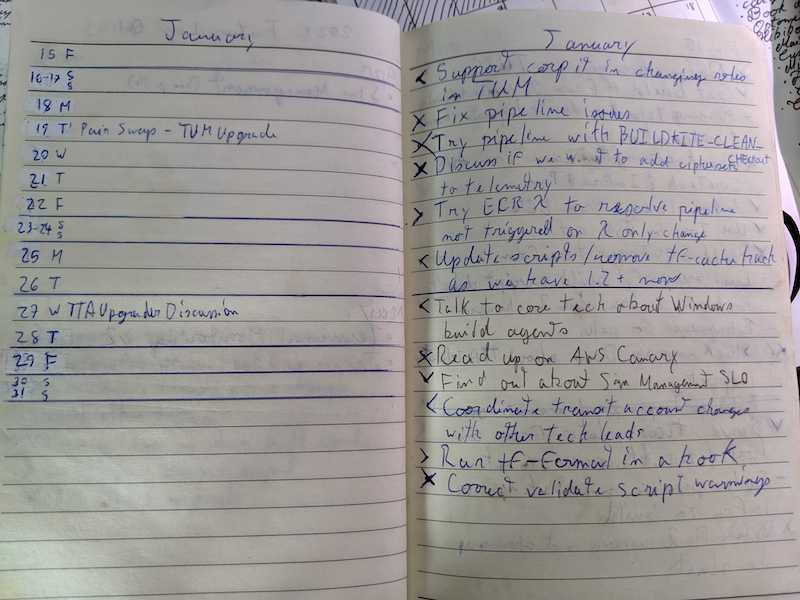
My first bullet journal 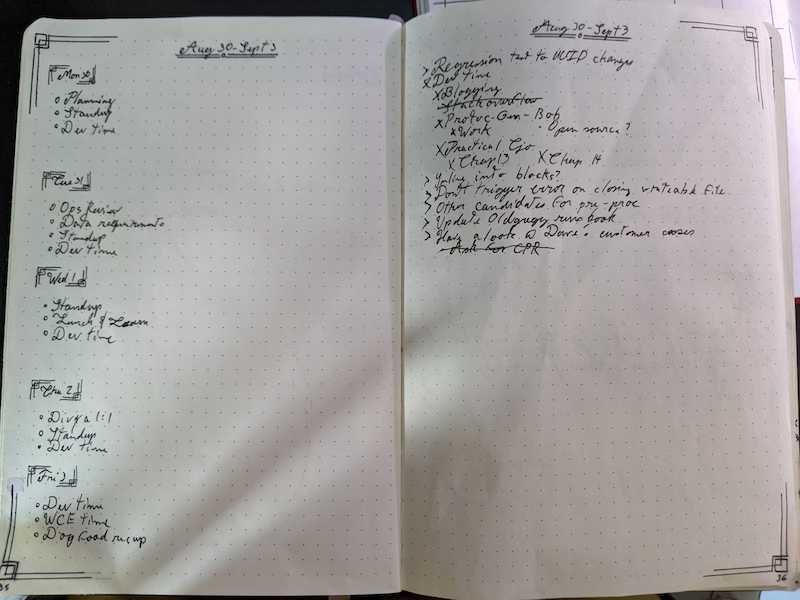
My current bullet journal - A pen - A simple ballpoint pen is enough. I lose my pens all the time, so I gave up very quickly on keeping the colour consistent, it’s more important to just write stuff down. Should you want to get creative, I like to use a 0.1 mm artist pen for fine lines and a 0.3 mm for writing. I’ve started getting into fountain pens lately. They are great for journaling, but it’s important to have quality paper if you want to use them.
The sections
These are the sections I use in my journal. There are a ton of different things that can be added. I like to keep things simple and stick to these four. I’ve listed them in order of frequency.
The daily log
This is the core of the system, where we log events, tasks and notes. It doesn’t need to be anything fancy just jot down things as they happen. Mine looks a bit like this:
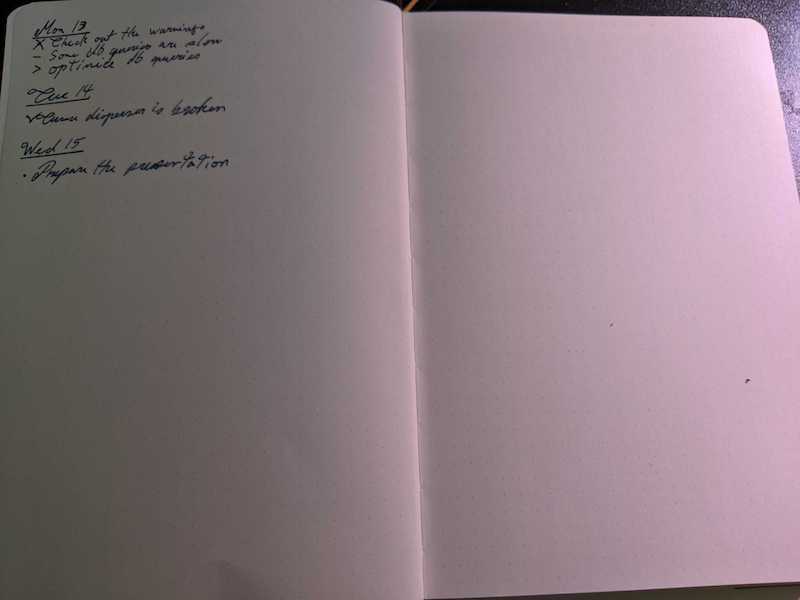
I usually start my day by writing out the day’s header and grooming yesterday’s log while I drink my coffee. Grooming involves crossing off tasks I’ve
done but forgot to cross out. Any leftover tasks I either move to today (represented by a right pointing chevron >) or move to the weekly log
(represented by a left pointing chevron <)
During the day if I need to note anything down for later, I’ll just jot it down here. This is particularly handy when context switching is necessary, or you want to get back to an interruption later. I’ve written a post on handling context switching here.
The weekly log
I use the weekly log to hold events like meetings and track my personal development time and other tasks that I want to do when I have a bit of time to spare.
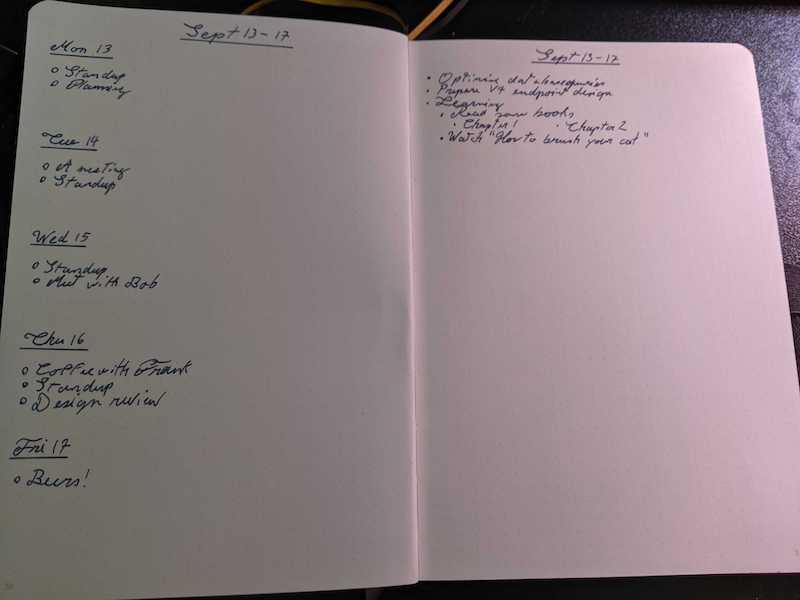
It can be tempting to write a ton of things here on a monday morning after that first coffee. However, I’ve found that it’s helpful to be realistic in what you can achieve during the week. Don’t feel bad if you can’t do everything you write down, just migrate things to the next week or to the future log if they can wait.
The future log
The future log is handy to plonk down things you’d like to do but can’t get to this week. I tried to do these quarterly at first but kept running out of space. In the end I find that bi-monthly is a good balance. That way each month gets its own page, and I don’t have to flip back halfway through my journal when I’m nearing the end of the future log period.
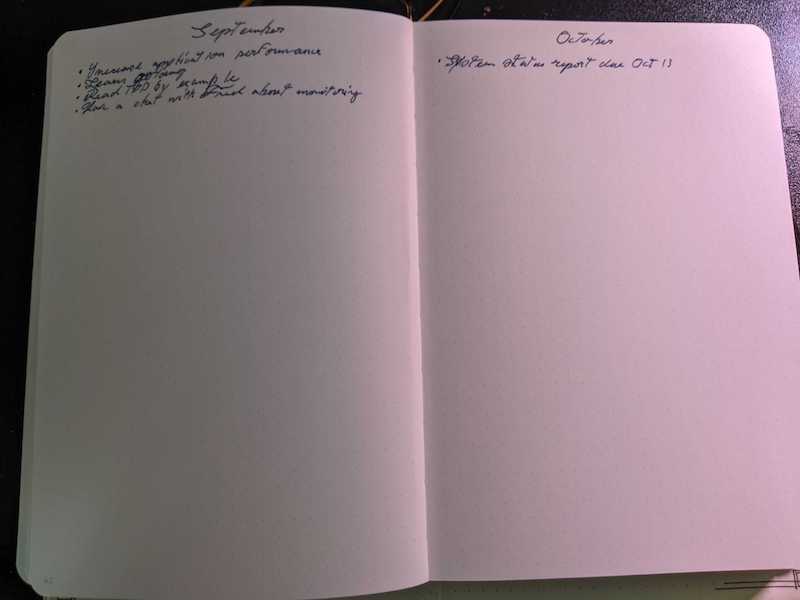
It’s a great place to write down big objectives too. For example, let’s say I want to read a textbook on algorithm design. Is it realistic to fit all
that in one week? It isn’t for me anyway! In this case I’ll write in my future log for the month something
like ⦁ Read 'Awesome Algorithms in their natural habitats' and each week write a chapter or two to read in my weekly log. That way I can commit
myself to progressing each week without feeling disheartened from carrying the same task over for weeks on end.
The index
The index can be a bit counter-intuitive in that it’ll stay empty for a while and we’ll just add things into it after we’ve written them. Just remember to leave some space in the beginning of the book for it. Or the end if that’s more your jam, or not at all, it’s your journal so whatever works for you is the way to go. I’m terrible at keeping my index up to date, I usually go back and update it at the start of the month and ignore it otherwise.
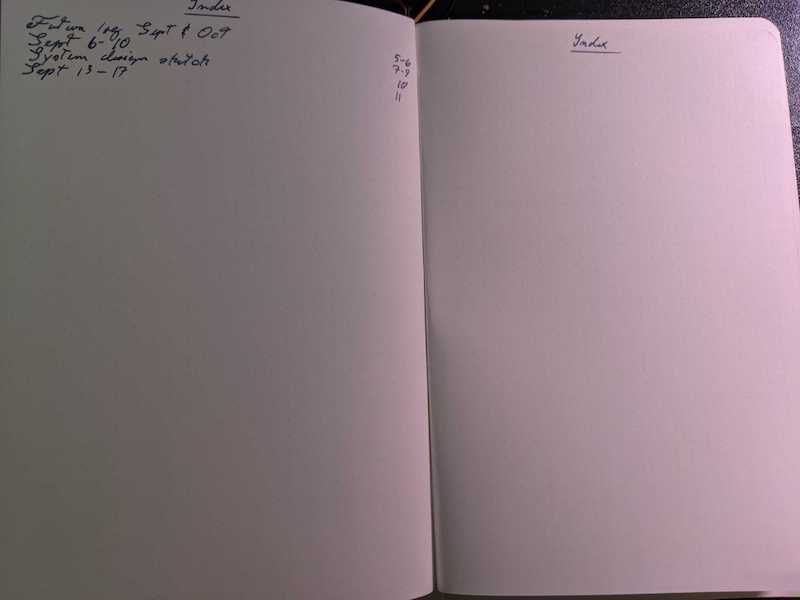
Tips and techniques
- In a leadership role, I’ve used a downward chevron to indicate I’ve delegated a task to one of my team. I also use this once I’ve put something in the team’s backlog, as I don’t need to keep track of it myself I don’t want it cluttering things up.
- Sometimes I get a blank page that needs to be skipped over for the next weekly log. I usually save a space for these in my index and use them to jot down some notes for a meeting, write up a test plan or scribble a quick systems design. By having them in my index I can just look for the first blank space in my book when I find myself in need of a page or two.
- The most important tip I can think of is to remember that this is a journal for you. There is no ‘right’ way to structure it. If it works for you, you’re doing it right!
- I might get of flak for this from fountain pen enthusiasts, but I’ve found that flipping the pen and writing with the back of the nib makes thinner lines. My pen seems fine but not sure if it’ll have long term negative impact…
[^1] Mejia, Zameena (2017-08-02) . “How the creator behind the viral bullet journal turned his own life hack into a full-time business” . CNBC. Retrieved 2021-08-16.
Comments